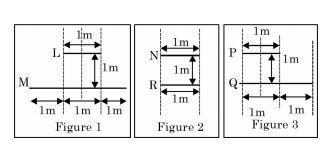Heat Transfer Miscellaneous
- Which one of the following configurations has the highest fin effectiveness?
-
View Hint View Answer Discuss in Forum
NA
Correct Option: A
NA
- The heat loss from a fin is 6 W. The effectiveness and efficiency of the fin are 3 and 0.75 respectively. The heat loss (in W) from the fin, keeping the entire fin surface at base temperature is _____.
-
View Hint View Answer Discuss in Forum
ηfin = qactual qmaximum possible qmax = 6 = 8 W 0.75 Correct Option: B
ηfin = qactual qmaximum possible qmax = 6 = 8 W 0.75
- A solid sphere of radius r1 = 20 mm is placed concentrically inside a hollow sphere of radius r2 = 30 mm as shown in the figure.

The view factor F21 for radiation heat transfer is
-
View Hint View Answer Discuss in Forum
F11 + F12 = 1, here F11 = 0
∴ F12 = 1
Now from reciprocating law
A1 F12 = A2 F21
∴ 22π (20)2 × 1 = 2π (30)2 × F21⇒ F21 = 
10 
2 = 4 30 9 Correct Option: B
F11 + F12 = 1, here F11 = 0
∴ F12 = 1
Now from reciprocating law
A1 F12 = A2 F21
∴ 22π (20)2 × 1 = 2π (30)2 × F21⇒ F21 = 
10 
2 = 4 30 9
- Three sets of parallel plates LM, NR and PQ are given in Figures 1, 2 and 3. The view factor Fij is defined as the fraction of radiation leaving plate I that is intercepted by plate J. Assume that the val ues of FL M and FN R ar e 0.8 and 0.4, respectively. The value of FPQ (round off to one decimal place) is _____.

-
View Hint View Answer Discuss in Forum

FLM = F(I) + F(II) + F(III)
Where F is shape factor of surface area I, II and III of M with surface area of ‘L’
0.8 = F(I) + F(II) + F(III)
∵ (I) and (III) are symmetrical in shape so, shape factor of these surface will be same i.e. F(I) = F(III)
So, 0.8 = 2F(I) + F(II)... (1)
In this area (II) is same as fig. (I) area II.
i.e. FNR = F(II) = 0.4... (2)
From equation (1),F(III) = 0.8 - 0.4 = 0.2 2 
Here, FPQ = F(II) + F(III)
= 0.4 + 0.2 = 0.6
Correct Option: B

FLM = F(I) + F(II) + F(III)
Where F is shape factor of surface area I, II and III of M with surface area of ‘L’
0.8 = F(I) + F(II) + F(III)
∵ (I) and (III) are symmetrical in shape so, shape factor of these surface will be same i.e. F(I) = F(III)
So, 0.8 = 2F(I) + F(II)... (1)
In this area (II) is same as fig. (I) area II.
i.e. FNR = F(II) = 0.4... (2)
From equation (1),F(III) = 0.8 - 0.4 = 0.2 2 
Here, FPQ = F(II) + F(III)
= 0.4 + 0.2 = 0.6
- For flow of fluid over a heated plate, the following fluid properties are known: viscosity = 0.001 Pa.s; specific heat at constant pressure = 1 kJ/kgK; thermal conductivity = 1 W/mK. The hydrodynamic boundary layer thickness at a specified location on the plate is 1 mm. The thermal boundary layer thickness at the same location is
-
View Hint View Answer Discuss in Forum
Given:
µ =0.001 Pa – s
CP = 1 kJ/kg K
Kf = 1W/mK (Fluid thermal conductivity)
Hydrodynamic boundary layer thickness, δ = 1 mmPr = μCP = 0.001 × 1000 = 1 Kf 1
δ t = δ (Cr)-1/3
= 1 × (1)-1/3 = 1 mmCorrect Option: C
Given:
µ =0.001 Pa – s
CP = 1 kJ/kg K
Kf = 1W/mK (Fluid thermal conductivity)
Hydrodynamic boundary layer thickness, δ = 1 mmPr = μCP = 0.001 × 1000 = 1 Kf 1
δ t = δ (Cr)-1/3
= 1 × (1)-1/3 = 1 mm

